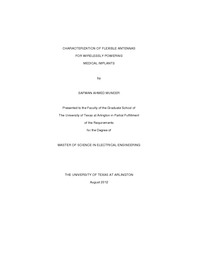
ATTENTION: The works hosted here are being migrated to a new repository that will consolidate resources, improve discoverability, and better show UTA's research impact on the global community. We will update authors as the migration progresses. Please see MavMatrix for more information.
Show simple item record
| dc.contributor.author | Ahmed Muneer, Safwan | en_US |
| dc.date.accessioned | 2013-03-20T19:13:11Z | |
| dc.date.available | 2013-03-20T19:13:11Z | |
| dc.date.issued | 2013-03-20 | |
| dc.date.submitted | January 2012 | en_US |
| dc.identifier.other | DISS-11846 | en_US |
| dc.identifier.uri | http://hdl.handle.net/10106/11634 | |
| dc.description.abstract | To minimize the trouble experienced by the patient in undergoing invasive surgeries to replace non rechargeable batteries that are used to power body implants inside, medical experts and engineers are emphasizing on making use of wireless power. Since body implant powering from external wireless power requires a source that can be easily worn outside the body, a special type of integrated antenna was implemented on a flexible substrate that conforms to the shape of the stomach curvature, thus adding increased patient comfort. The antenna bend is concave which adds to increased focus and increases power transfer efficiency to power the body implant. Since the dielectric constant of body cells increases with the increase in the frequency of operation of the system, the frequency used is 1.3 MHz which is in the ISM band. Since research is underway to develop a whole new kind of body implants such as retinal implants, intracranial brain computer interfaces (BCI) etc., the demand for efficient powering of body implants from the outside using a compact source has increased to a great extent. In this research work, a square planar spiral antenna was fabricated using copper tape, mask and precision knife on a flexible substrate - kapton (polyimide) to power the tag antenna (body implant). A Class - E power amplifier was used to amplify the signal before transmitting it through the reader antenna to the tag antenna which in practical implementation would be attached to the body implant. A non - planar antenna made using 24 AWG magnet wire on a Styrofoam substrate was used to receive the power. Both the reader antenna and tag antenna were resonated using appropriate capacitors to achieve maximum power transfer. In order to understand the power transfer pattern in a human body through the stomach, a stable setup and curvatures of different size were used. Since the reader antenna will be worn in the form of a belt, it was bent at different radii of curvature. The tag antenna or the reader antenna can move sideways or radially, experiments were executed to incorporate all these effects and the results for the power transfer efficiency were recorded. Accidently, it was found that the power transfer efficiency increased when the reader antenna was bent rather than straight. The feasibility of the efficiency pattern that is obtained by displacing the reader and tag antennas is confirmed by fabricating antennas with different designs and obtaining the repeatable pattern. This pattern can be used as a reference pattern to optimize the parameters of the reader antenna for optimum power transfer efficiency. Ansoft HFSS, simulation software that makes use of finite element method (FEM) to perform 3D electromagnetic simulations was used to simulate the inductance of the reader antenna. The reader antenna 3D model made using the software was bent to emulate the reader antenna bend along the stomach curvature, using AutoCAD software and Bonzai 3d software and the model was imported into HFSS and the simulations were verified with the experiment. HFSS simulations were also verified using equations given by T.H Lee in [17]. Thus, the experimental results, simulation results, and results obtained from equations were in good agreement with each other. The simulation work was thus used as a proof of concept for antenna design. | en_US |
| dc.description.sponsorship | Chiao, Jung-Chih | en_US |
| dc.language.iso | en | en_US |
| dc.publisher | Electrical Engineering | en_US |
| dc.title | Characterization Of Flexible Antennas For Wirelessly Powering Medical Implants | en_US |
| dc.type | M.S. | en_US |
| dc.contributor.committeeChair | Chiao, Jung-Chih | en_US |
| dc.degree.department | Electrical Engineering | en_US |
| dc.degree.discipline | Electrical Engineering | en_US |
| dc.degree.grantor | University of Texas at Arlington | en_US |
| dc.degree.level | masters | en_US |
| dc.degree.name | M.S. | en_US |
Files in this item
- Name:
- AHMEDMUNEER_uta_2502M_11846.pdf
- Size:
- 2.895Mb
- Format:
- PDF
This item appears in the following Collection(s)
Show simple item record


